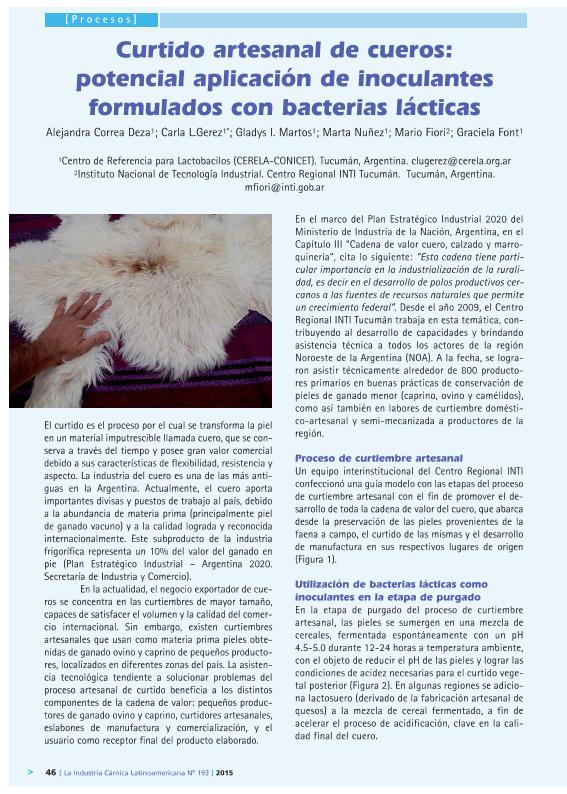Artículo
El curtido es el proceso por el cual se transforma la piel en un material imputrescible llamada cuero, que se conserva a través del tiempo y posee gran valor comercial debido a sus características de flexibilidad, resistencia y
aspecto. La industria del cuero es una de las más antiguas en la Argentina. Actualmente, el cuero aporta importantes divisas y puestos de trabajo al país, debido a la abundancia de materia prima (principalmente piel de ganado vacuno) y a la calidad lograda y reconocida internacionalmente. Este subproducto de la industria frigorífica representa un 10% del valor del ganado en pie (Plan Estratégico Industrial – Argentina 2020. Secretaría de Industria y Comercio).
En la actualidad, el negocio exportador de cueros se concentra en las curtiembres de mayor tamaño, capaces de satisfacer el volumen y la calidad del comercio
internacional. Sin embargo, existen curtiembres artesanales que usan como materia prima pieles obtenidas de ganado ovino y caprino de pequeños productores, localizados en diferentes zonas del país. La asistencia
tecnológica tendiente a solucionar problemas del proceso artesanal de curtido beneficia a los distintos componentes de la cadena de valor: pequeños productores de ganado ovino y caprino, curtidores artesanales, eslabones de manufactura y comercialización, y el usuario como receptor final del producto elaborado. The tanning process allows to transform animal skin in stable and non-putrescible products namely leather. This process consists in various steps such as washing skins, liming, depilation, lime removal by washing, purging and tanning. During purging, the skins are immersed in a cereal mix which is let to ferment for 12-24 h at room temperature (18ºC-37°C). After this period, the pH decreased to 4.5-5.0, a condition that is required for the final steps. Under these homemade working conditions, the cereal fermentation is quite variable and affects the quality of the leather. The objective of this study was to isolate lactic acid bacteria (LAB) from the fermented cereal mixture in artisanal tanneries and to evaluate in vitro the acidifying activity of the strains. This is the first step for the formulation of a starter culture for tanneries to normalize the process.Samples of fermented cereals were taken from a tannery located in San Pedro de Colalao, Tucumán, Argentina, and colonies were isolated in MRS agar medium. The primary identification of the isolates included Gram stain, microscopic observations and catalase reaction. Gram positive, catalase negative strains (23) were cultured in a CERELA medium formulated for the production of lactic ferment and incubated at 18°C and 37°C for 24 h. At intervals, pH and titratable acidity (TTA) were determined. In most samples, a prevalence of cocci (95%) respect to bacilli was observed. The total isolated strains (56), 23 strains were Gram (+) and catalase (negative) which were selected. At 37 °C, most strains (21) acidified the culture medium within the first 8-h reaching a final pH ≤ 5.0 and a TTA ≥100ºD. At 18 °C, all strains showed a lower growth; however, the decrease in pH was 4.5-5.0 and the acidity developed (100-140ºD) after 24 hours of fermentation were similar to values obtained at 37°C. The best acid-producer strains were identified as Enterococcus faecium CRL 1943 and Leuconostoc citreum CRL 1945 by phenotypic and genotypic techniques. Currently, studies are being conducted to formulate a lactic inoculant on the basis of these strains and their metabolites for artisanal tanning.
Curtido artesanal de cueros: potencial aplicación de inoculantes formulados con bacterias lácticas.
Correa Deza, Maria Alejandra; Gerez, Carla Luciana ; Martos, Gladys Irma
; Martos, Gladys Irma ; Nuñez, Martha Susana
; Nuñez, Martha Susana ; Fiori, Mario; Font, Graciela Maria
; Fiori, Mario; Font, Graciela Maria
 ; Martos, Gladys Irma
; Martos, Gladys Irma ; Nuñez, Martha Susana
; Nuñez, Martha Susana ; Fiori, Mario; Font, Graciela Maria
; Fiori, Mario; Font, Graciela Maria
Fecha de publicación:
07/2015
Editorial:
Publitec
Revista:
La Industria Cárnica Latinoamericana
ISSN:
0325-3414
Idioma:
Español
Tipo de recurso:
Artículo publicado
Clasificación temática:
Resumen
Palabras clave:
Bacterias Lacticas
,
Cereales
,
Curtiembre
Archivos asociados
Licencia
Identificadores
Colecciones
Articulos(CERELA)
Articulos de CENTRO DE REFERENCIA PARA LACTOBACILOS (I)
Articulos de CENTRO DE REFERENCIA PARA LACTOBACILOS (I)
Citación
Correa Deza, Maria Alejandra; Gerez, Carla Luciana; Martos, Gladys Irma; Nuñez, Martha Susana; Fiori, Mario; et al.; Curtido artesanal de cueros: potencial aplicación de inoculantes formulados con bacterias lácticas.; Publitec; La Industria Cárnica Latinoamericana; XL; 193; 7-2015; 46-48
Compartir



